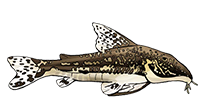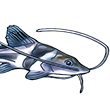Common Bristlenose Scientific Name
Common Bristlenose Scientific Name
Why is it that the "common" bristlenose doesn't seem to have a clear scientific name? Is it because there are so many versions of the fish, or is it just plain taxonomic confusion? Forgive the question, I'm pretty new to this naming stuff.
- Silurus
- Posts: 12460
- Joined: 31 Dec 2002, 11:35
- I've donated: $12.00!
- My articles: 55
- My images: 896
- My catfish: 1
- My cats species list: 90 (i:1, k:0)
- Spotted: 428
- Location 1: Singapore
- Location 2: Moderator Emeritus
- MatsP
- Posts: 21038
- Joined: 06 Oct 2004, 13:58
- My articles: 4
- My images: 28
- My cats species list: 117 (i:33, k:0)
- My aquaria list: 10 (i:8)
- My BLogs: 4 (i:0, p:164)
- Spotted: 187
- Location 1: North of Cambridge
- Location 2: England.
It's exactly that: Common Bristlenose isn't ONE single specie, it's several different species that look pretty similar.
I'm not sure if a factor in this is also that some of the species may not be properly named either (there are a couple of hundred different Loricariid's, which is the "great family" of pl*co's, that haven't been properly named yet).
I'm not sure exactly how this naming business works when it comes to identifying new species, but I think the principle is:
1. Find a fish that doesn't look like anything you've seen before.
2. Ask around to see if anyone else knows what it is. If someone does (and it actually matches the fish you've got), then you go back to step 1.
3. You describe the fish in detail, including it's specific characteristics in comparison with other specie(s) of this family.
4. You publish your description to the scientific community.
5. You receive all sorts of suggestions that this is not as you say, but indeed a fish of the specie X or Y. If you can't prove otherwise, go back to 1.
6. Voila, you've got a new specie...
[This is of course a bit "trivialized", and I'm not trying to ridicule scientists, I think they do a splendid job. I'm just trying to describe it in laymans terms and trying to make it a bit fun at the same time].
Maybe HH (Silurus) can tell more about the process, because I think he's doing that sort of work...
--
Mats
I'm not sure if a factor in this is also that some of the species may not be properly named either (there are a couple of hundred different Loricariid's, which is the "great family" of pl*co's, that haven't been properly named yet).
I'm not sure exactly how this naming business works when it comes to identifying new species, but I think the principle is:
1. Find a fish that doesn't look like anything you've seen before.
2. Ask around to see if anyone else knows what it is. If someone does (and it actually matches the fish you've got), then you go back to step 1.
3. You describe the fish in detail, including it's specific characteristics in comparison with other specie(s) of this family.
4. You publish your description to the scientific community.
5. You receive all sorts of suggestions that this is not as you say, but indeed a fish of the specie X or Y. If you can't prove otherwise, go back to 1.
6. Voila, you've got a new specie...
[This is of course a bit "trivialized", and I'm not trying to ridicule scientists, I think they do a splendid job. I'm just trying to describe it in laymans terms and trying to make it a bit fun at the same time].
Maybe HH (Silurus) can tell more about the process, because I think he's doing that sort of work...
--
Mats
Common Bristlenose
Hi, Ingo Seidel assumes that there are different species already involved and that the aquarium "species" may be a hybrid. Harro
- Shane
- Expert
- Posts: 4646
- Joined: 30 Dec 2002, 22:12
- My articles: 69
- My images: 162
- My catfish: 75
- My cats species list: 4 (i:0, k:0)
- My aquaria list: 4 (i:4)
- Spotted: 99
- Location 1: Tysons
- Location 2: Virginia
- Contact:
Harro,
Great to hear from you. I have heard the same thing said, but have yet to see any information to back it up. I am not saying that it is impossible for Ancistrus spp. to hybridize, but I think it is a great leap to say they are hybrids just because we can not identify them to sp.
It is kind of like the Synodontis situation. Because a number of hybrids have come from eastern Europe, everyone screams "hybrid" everytime a new spp. shows up in the trade.
-Shane
Great to hear from you. I have heard the same thing said, but have yet to see any information to back it up. I am not saying that it is impossible for Ancistrus spp. to hybridize, but I think it is a great leap to say they are hybrids just because we can not identify them to sp.
It is kind of like the Synodontis situation. Because a number of hybrids have come from eastern Europe, everyone screams "hybrid" everytime a new spp. shows up in the trade.
-Shane
"My journey is at an end and the tale is told. The reader who has followed so faithfully and so far, they have the right to ask, what do I bring back? It can be summed up in three words. Concentrate upon Uganda."
Winston Churchill, My African Journey
Winston Churchill, My African Journey
- Caol_ila
- Posts: 1281
- Joined: 02 Jan 2003, 12:09
- My images: 52
- Spotted: 23
- Location 1: Mainz, Germany
@shane there was an article by a hobbyist some time ago in Das Aquarium.
He writes that he crossbred two Ancistrus species he received from a credible source (i think it was a spotted one and a greenish-olive unspotted one) the results looked like "commons" that you can buy here in Germany. He also spread them around to lfs and friends...
Not sure where i have the mag but i can check when i go to my girls place midweek. Or maybe somebody else can make a better resume
He writes that he crossbred two Ancistrus species he received from a credible source (i think it was a spotted one and a greenish-olive unspotted one) the results looked like "commons" that you can buy here in Germany. He also spread them around to lfs and friends...
Not sure where i have the mag but i can check when i go to my girls place midweek. Or maybe somebody else can make a better resume
cheers
Christian
Christian
- Shane
- Expert
- Posts: 4646
- Joined: 30 Dec 2002, 22:12
- My articles: 69
- My images: 162
- My catfish: 75
- My cats species list: 4 (i:0, k:0)
- My aquaria list: 4 (i:4)
- Spotted: 99
- Location 1: Tysons
- Location 2: Virginia
- Contact:
The question then is whether his hybrids "represented" the common Ancistrus found in the trade (Very unlikely. What are they chances that the common Ancistrus would be hybrids of the exact same two spp. he just happened to have crossed?) or is it more likely the hybrids just bore a coincidental resemblance?
If he distributed his fry and they were fertile and spawned by aquarists... that is a serious problem.
-Shane
If he distributed his fry and they were fertile and spawned by aquarists... that is a serious problem.
-Shane
"My journey is at an end and the tale is told. The reader who has followed so faithfully and so far, they have the right to ask, what do I bring back? It can be summed up in three words. Concentrate upon Uganda."
Winston Churchill, My African Journey
Winston Churchill, My African Journey
- Caol_ila
- Posts: 1281
- Joined: 02 Jan 2003, 12:09
- My images: 52
- Spotted: 23
- Location 1: Mainz, Germany
Hi!
I finally found the article.
Dietmar Franz had these spawns in 1990 between 2 species of Ancistrus that i cant find in the elog (the photos in the article are very crappy)...The olivgreen male paired with a spotted species female and they spawned in a plastic cup under the filter. The fry were uniform in color/pattern and fertile. The F2 showed a big variety in colors/pattern from both m/f. He also spread these hybrids to friends and shops because he thinks hybrids are a natural form of species building...
I finally found the article.
Dietmar Franz had these spawns in 1990 between 2 species of Ancistrus that i cant find in the elog (the photos in the article are very crappy)...The olivgreen male paired with a spotted species female and they spawned in a plastic cup under the filter. The fry were uniform in color/pattern and fertile. The F2 showed a big variety in colors/pattern from both m/f. He also spread these hybrids to friends and shops because he thinks hybrids are a natural form of species building...
cheers
Christian
Christian






